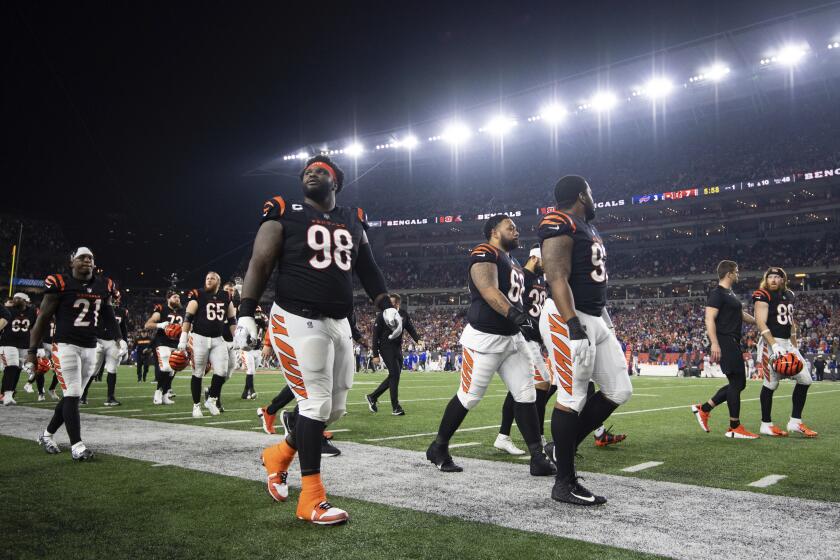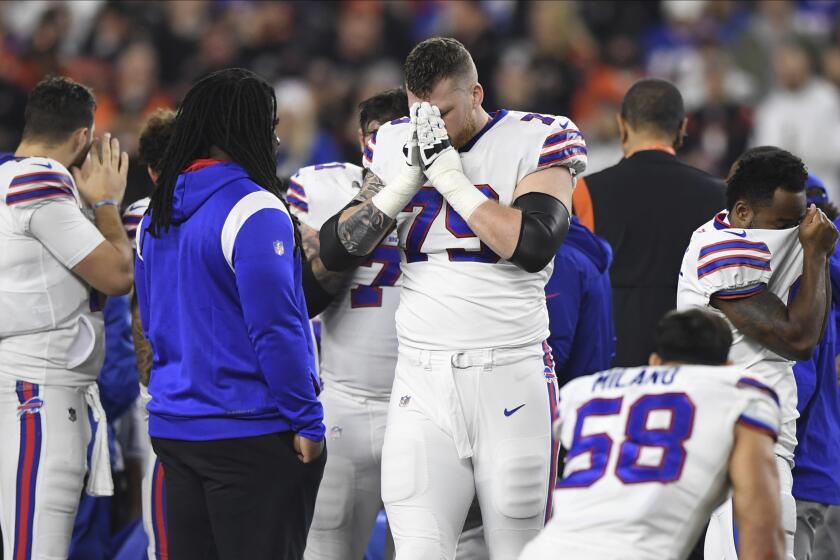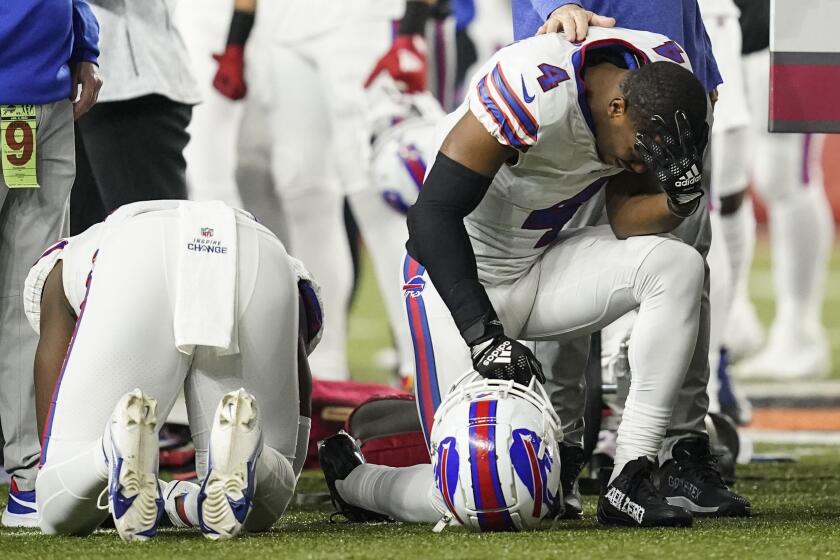Op-Ed: Is there something about Americans that makes us football addicts?

I teach a course on the intersection of sports and religion in North America, and I ask students whether there is something about American society that draws us to the violence of football. Why, for instance, despite the NFL’s best efforts, has American football not caught on elsewhere in the world, whereas by most metrics it is America’s most popular game?
Sure, violence erupts from time to time in other sports — the consequence of a beanball pitch or an inadvertent collision in the heat of competition. Hockey certainly has its share of violence, but unlike that sport, violence is scripted into the game of football itself, as we were reminded seeing Damar Hamlin collapse during Monday night’s game between the Buffalo Bills and the Cincinnati Bengals.
Violence has always been part of the game. Nearly every account of a 19th century football game I’ve read includes the words “brutal” or “brutality.”
In 1971, when a player died during a game, the league expected business to continue as usual. The response Monday was far more humane.
American football, a military game concerned with the conquest and the defense of territory, evolved from the English game of rugby in the years following the American Civil War. Walter Camp of Yale, generally considered the father of American football, disliked the chaos of the rugby scrum and sought to introduce more strategy into the game. He finally succeeded in persuading his Ivy League colleagues to trade the scrum for the line of scrimmage, thereby allowing for more strategic possibilities and, he argued, a reduction in the violence associated with the game.
Whether the latter worked is debatable. Separating the teams between downs may have diminished the anarchy of the scrum, but it also allowed players to generate momentum before crashing into opponents. Bloodied bodies, displaced dentition, broken and amputated limbs were commonplace. The Journal of the American Medical Assn. counted 12 deaths from football in 1902, and at the conclusion of the 1905 season the Chicago Tribune tallied the season’s “death harvest”: 159 serious injuries and 19 fatalities.
An injury to his own son while playing on the Harvard freshman team prompted President Theodore Roosevelt to summon representatives from Princeton, Yale and Harvard to the White House. At the meeting, which even included the secretary of State, Roosevelt bellowed, “Change the game or forsake it!”
The NFL says the Bills-Bengals game, suspended after Damar Hamlin suffered cardiac arrest, won’t be completed this week as Hamlin remains in critical condition.
College officials responded by forming the Intercollegiate Athletic Assn. and eventually altering the rules. Among other changes, they eliminated the flying wedge and allowed the forward pass, which made the game marginally safer. Casualties rose again in 1909, however: two fatalities, and the Navy quarterback was paralyzed in a game against Villanova University.
Violence accounts for much of the appeal of the game, then and now, and the history of American football suggests that fans and players are willing to tolerate injuries for the continuation of the game. “It’s the violence of the sport,” Hall of Fame quarterback Troy Aikman observed. “The violence of the sport attracts us to the game.”
Which brings us back to the question about whether there is something about American society that draws us — myself included, by the way — to the carnage of football.
By any measure, the United States is a violent society, an observation confirmed in the daily newspaper and the nightly news with horrific stories about mass shootings and homicide data. Consider the unspeakable violence of slavery in America’s past, rape statistics and hate crimes directed against ethnic and racial minorities. The emergence of the game of football coincided with the 19th century push into the West beneath the banner of Manifest Destiny, the Civil War and the Spanish-American War.
Five years earlier, on the same field where Damar Hamlin collapsed, Robert Golden saw Steelers teammate Ryan Shazier suffer a serious spinal injury.
The earliest football games reflected the military objective of annihilation of the adversary. The big three football powerhouses — Princeton, Harvard, Yale — routinely destroyed their appointments on the gridiron. In 1888, for example, Yale outscored its opponents 698 to 0; two years later, Princeton beat four opponents: 50-0, 60-0, 115-0 and 85-0. “A game of football is a battle,” one contemporary noted, whose object is “the destruction (figurative) or the overwhelming of the enemy.”
“Football appeals so strongly to the American public because it is a war game,” Charles Dudley Daly, Harvard quarterback and later head coach at West Point, remarked in 1921. “The most remarkable similarity exists between the basic principles of combat in war and in football.”
Perhaps this American affinity with militarism is what draws us to football and allows us to tolerate the violence embedded in the game.
Randall Balmer is a professor at Dartmouth College and the author of “Passion Plays: How Religion Shaped Sports in North America.”
More to Read
A cure for the common opinion
Get thought-provoking perspectives with our weekly newsletter.
You may occasionally receive promotional content from the Los Angeles Times.













